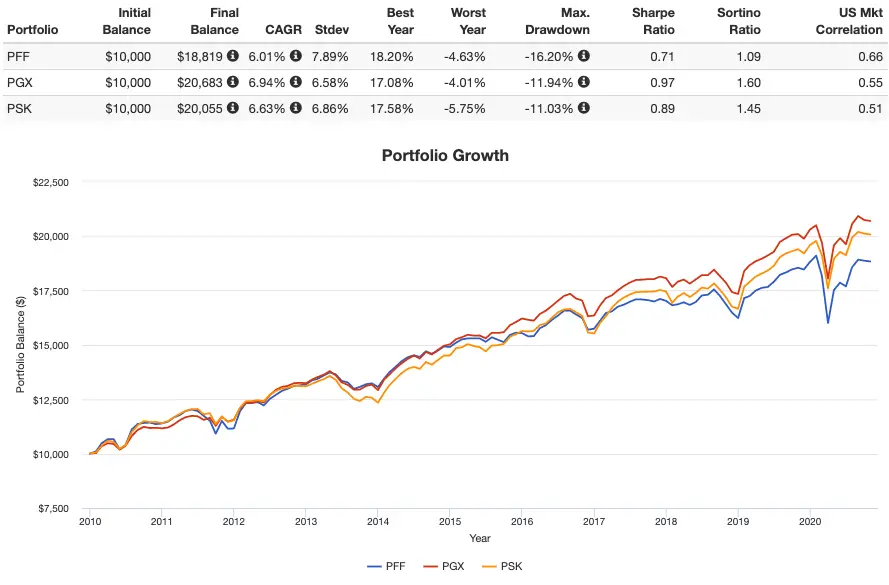Preferred stock shares typically trade some capital appreciation for higher dividend yields. Here we'll look at the best preferred stock ETFs and why you might (not) want to use them.
Disclosure: Some of the links on this page are referral links. At no additional cost to you, if you choose to make a purchase or sign up for a service after clicking through those links, I may receive a small commission. This allows me to continue producing high-quality content on this site and pays for the occasional cup of coffee. I have first-hand experience with every product or service I recommend, and I recommend them because I genuinely believe they are useful, not because of the commission I may get. Read more here.
Contents
Video
Prefer video? Watch it here:
Introduction – Why Preferred Stock?
Preferred stock shares – as opposed to common stock – have preferential claim to dividend distributions. Dividends are typically higher for preferred shares than for common shares, so preferred stock is common among dividend investors.
Preferred stock also has more stability than common stock. It exhibits aspects of common stock and bonds, and can be seen as somewhat of an in-between asset. Preferred shareholders trade voting rights for higher yields. Preferred stock holders also take priority in cases of financial troubles or liquidations. Preferred stock is ideal for risk-averse investors seeking fixed, predictable dividend payments.
Below we'll look at the best preferred stock ETFs.
The 3 Best Preferred Stock ETFs
Below are the 3 best preferred stock ETFs.
PFF – iShares Preferred and Income Securities ETF
The iShares Preferred and Income Securities ETF (PFF) seeks to track the S&P U.S. Preferred Stock Index, providing broad, diversified exposure to preferred stock traded on the NYSE and NASDAQ. The fund has over $16 billion and an expense ratio of 0.46%. Note that this ETF inherently overweights the Financials sector due to its holdings.
PGX – Invesco Preferred ETF
Unlike PFF above, the Invesco Preferred ETF (PGX) screens for credit rating. Its holdings can thus be considered higher quality. This usually means lower volatility; PGX has historically had the lowest volatility of the 3 funds on this list. The fund seeks to track the ICE BofAML Core Plus Fixed Rate Preferred Securities Index and has an expense ratio of 0.51%.
PSK – SPDR Wells Fargo Preferred Stock ETF
The SPDR Wells Fargo Preferred Stock ETF (PSK) achieves arguably better diversification than the above funds because it limits any individual holding to a 5% weight, meaning it is not financials-heavy. PSK has had the smallest historical drawdown of the funds on this list. This ETF is comparatively less liquid but is also slightly cheaper than the above funds with an expense ratio of 0.45%.
If I were choosing one of these, I would probably go with PGX from Invesco. You can see it in red in the backtest below. The slightly higher expense ratio seems like a worthy trade-off for its credit rating screen, and historically it has delivered the highest return with the lowest volatility, meaning it has the highest risk-adjusted return of these funds:

But Should You Buy Preferred Stocks? Probably Not.
Preferred stocks sound fancy and attractive, but don't get sucked in too quickly.
First, preferred shares are still an equity investment. In the event of bankruptcy, a firm's debt holders are still getting paid before preferred shareholders. If a company is liquidated, the preferred shareholder is getting zilch.
Recall that preferred stocks have aspects of bonds. Traditional bonds have a fixed maturity date. Preferred stocks don't. Preferred shares are like corporate bonds with a perpetual maturity. Talk about credit risk…
Preferred stocks are also typically callable. I delved into why this stinks when talking about convertible bonds. Basically, if interest rates fall, the investor's upside potential is capped because the issuer would just call the preferred stock. This creates an asymmetric risk/return profile for preferred stocks. That is, the callability basically cancels out any upside from long maturities.
Furthermore, companies usually issue preferred stock as a way to avoid a credit downgrading from taking on more debt or because they are simply unable to issue more debt. This alone should be a red flag.
Lastly, while that fixed dividend sounds nice, and while preferred shareholders do have preferential claim to dividends, those dividends can still be deferred in periods of market turmoil, whereas conventional bond interest would be more reliable. Missed dividends due to suspension do not have to be made up later.
The higher yield of preferred stocks does not adequately compensate the investor for these greater risks and inefficiencies. This doesn't even consider the fact that any investment vehicle for preferred stocks, like the funds listed above, are pretty expensive. As usual, retail investors are probably wise to stick with traditional stocks and bonds.
Where To Buy These Preferred Stock ETFs
If you want one, all the above preferred stock ETFs should be available at any major broker. My choice is M1 Finance. M1 has zero trade commissions and zero account fees, and offers fractional shares, dynamic rebalancing, intuitive pie visualization, and a sleek, user-friendly interface and mobile app. I wrote a comprehensive review of M1 Finance here.
Interested in more Lazy Portfolios? See the full list here.
Disclaimer: While I love diving into investing-related data and playing around with backtests, this is not financial advice, investing advice, or tax advice. The information on this website is for informational, educational, and entertainment purposes only. Investment products discussed (ETFs, mutual funds, etc.) are for illustrative purposes only. It is not a research report. It is not a recommendation to buy, sell, or otherwise transact in any of the products mentioned. I always attempt to ensure the accuracy of information presented but that accuracy cannot be guaranteed. Do your own due diligence. I mention M1 Finance a lot around here. M1 does not provide investment advice, and this is not an offer or solicitation of an offer, or advice to buy or sell any security, and you are encouraged to consult your personal investment, legal, and tax advisors. Hypothetical examples used, such as historical backtests, do not reflect any specific investments, are for illustrative purposes only, and should not be considered an offer to buy or sell any products. All investing involves risk, including the risk of losing the money you invest. Past performance does not guarantee future results. Opinions are my own and do not represent those of other parties mentioned. Read my lengthier disclaimer here.

Are you nearing or in retirement? Use my link here to get a free holistic financial plan and to take advantage of 25% exclusive savings on financial planning and wealth management services from fiduciary advisors at Retirable to manage your savings, spend smarter, and navigate key decisions.


John,
Looking at portfolio visualizer’s correlation of the VOO and PGX, it seems outside of inflationary periods, they have a low correlation. Given that low correlation with a still positive expected return, do you think it’s helpful in achieving a mild leveraged risk parity style portfolio?
No. As noted, preferred stocks have elements of stocks and bonds, so the correlation there is what we’d expect.